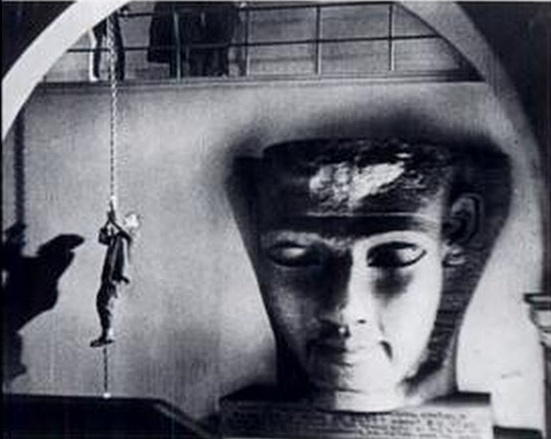Schüfftan process on:
[Wikipedia]
[Google]
[Amazon]
The Schüfftan process is a movie
 Over the following years, the Schüfftan process was used by many other film-makers, including
Over the following years, the Schüfftan process was used by many other film-makers, including
Videomaker article
{{DEFAULTSORT:Schufftan process Special effects Metropolis (1927 film)
special effect
Special effects (often abbreviated as SFX, F/X or simply FX) are illusions or visual tricks used in the theatre, film, television, video game, amusement park and simulator industries to simulate the imagined events in a story or virtual ...
named after its inventor, Eugen Schüfftan (1893–1977). The technique consists of covering part of the camera's view with a mirror, allowing filmmakers to assemble an image from multiple parts. It was widely used in the first half of the 20th century before being almost completely replaced by the travelling matte
Mattes are used in photography and special effects filmmaking to combine two or more image elements into a single, final image. Usually, mattes are used to combine a foreground image (e.g. actors on a set) with a background image (e.g. a scenic ...
and bluescreen effects.
Introduction
The process was refined and popularized by the German cinematographer Eugen Schüfftan while he was working on the movie ''Metropolis
A metropolis () is a large city or conurbation which is a significant economic, political, and cultural center for a country or region, and an important hub for regional or international connections, commerce, and communications.
A big c ...
'' (1927), although there is evidence that other film-makers were using similar techniques earlier than this. The movie's director, Fritz Lang
Friedrich Christian Anton Lang (; December 5, 1890 – August 2, 1976), known as Fritz Lang, was an Austrian film director, screenwriter, and producer who worked in Germany and later the United States.Obituary '' Variety'', August 4, 1976, p. ...
, wanted to insert the actors into shots of miniatures of skyscrapers and other buildings, so Schüfftan used a specially made mirror to create the illusion of actors interacting with huge, realistic-looking sets.
Schüfftan placed a plate of glass at a 45-degree angle between the camera and the miniature buildings. He used the camera's viewfinder
In photography, a viewfinder is what the photographer looks through to compose, and, in many cases, to focus the picture. Most viewfinders are separate, and suffer parallax, while the single-lens reflex camera lets the viewfinder use the main ...
to trace an outline of the area into which the actors would later be inserted onto the glass. This outline was transferred onto a mirror and all the reflective surface that fell outside the outline was removed, leaving transparent glass. When the mirror was placed in the same position as the original plate of glass, the reflective part blocked a portion of the miniature building behind it and also reflected the stage behind the camera. The actors were placed several meters away from the mirror so that when they were reflected in the mirror, they would appear at the right size.
In the same movie, Schüfftan used a variation of this process so that the miniature set (or drawing) was shown on the reflective part of the mirror and the actors were filmed through the transparent part.
 Over the following years, the Schüfftan process was used by many other film-makers, including
Over the following years, the Schüfftan process was used by many other film-makers, including Alfred Hitchcock
Sir Alfred Joseph Hitchcock (13 August 1899 – 29 April 1980) was an English filmmaker. He is widely regarded as one of the most influential figures in the history of cinema. In a career spanning six decades, he directed over 50 featur ...
, in his films ''Blackmail
Blackmail is an act of coercion using the threat of revealing or publicizing either substantially true or false information about a person or people unless certain demands are met. It is often damaging information, and it may be revealed to fa ...
'' (1929) and '' The 39 Steps'' (1935), and as recently as '' The Lord of the Rings: The Return of the King'' (2003), directed by Peter Jackson. The Schüfftan process has largely been replaced with matte
Matte may refer to:
Art
* paint with a non-glossy finish. See diffuse reflection.
* a framing element surrounding a painting or watercolor within the outer frame
Film
* Matte (filmmaking), filmmaking and video production technology
* Matte pa ...
shots, which allow the two portions of the image to be filmed at different times and give opportunities for more changes in post production.
The Schüfftan process's use of mirrors is very similar to the 19th century stage technique known as Pepper's ghost
Pepper's ghost is an illusion technique used in the theatre, cinema, amusement parks, museums, television, and concerts.
It is named after the English scientist John Henry Pepper (1821–1900) who began popularising the effect with a theatr ...
.
See also
* Bipack *Optical printer
An optical printer is a device consisting of one or more film projectors mechanically linked to a movie camera. It allows filmmakers to re- photograph one or more strips of film. The optical printer is used for making special effects for mot ...
* Special effect
Special effects (often abbreviated as SFX, F/X or simply FX) are illusions or visual tricks used in the theatre, film, television, video game, amusement park and simulator industries to simulate the imagined events in a story or virtual ...
s
* Traveling matte
References
*External links
*Videomaker article
{{DEFAULTSORT:Schufftan process Special effects Metropolis (1927 film)